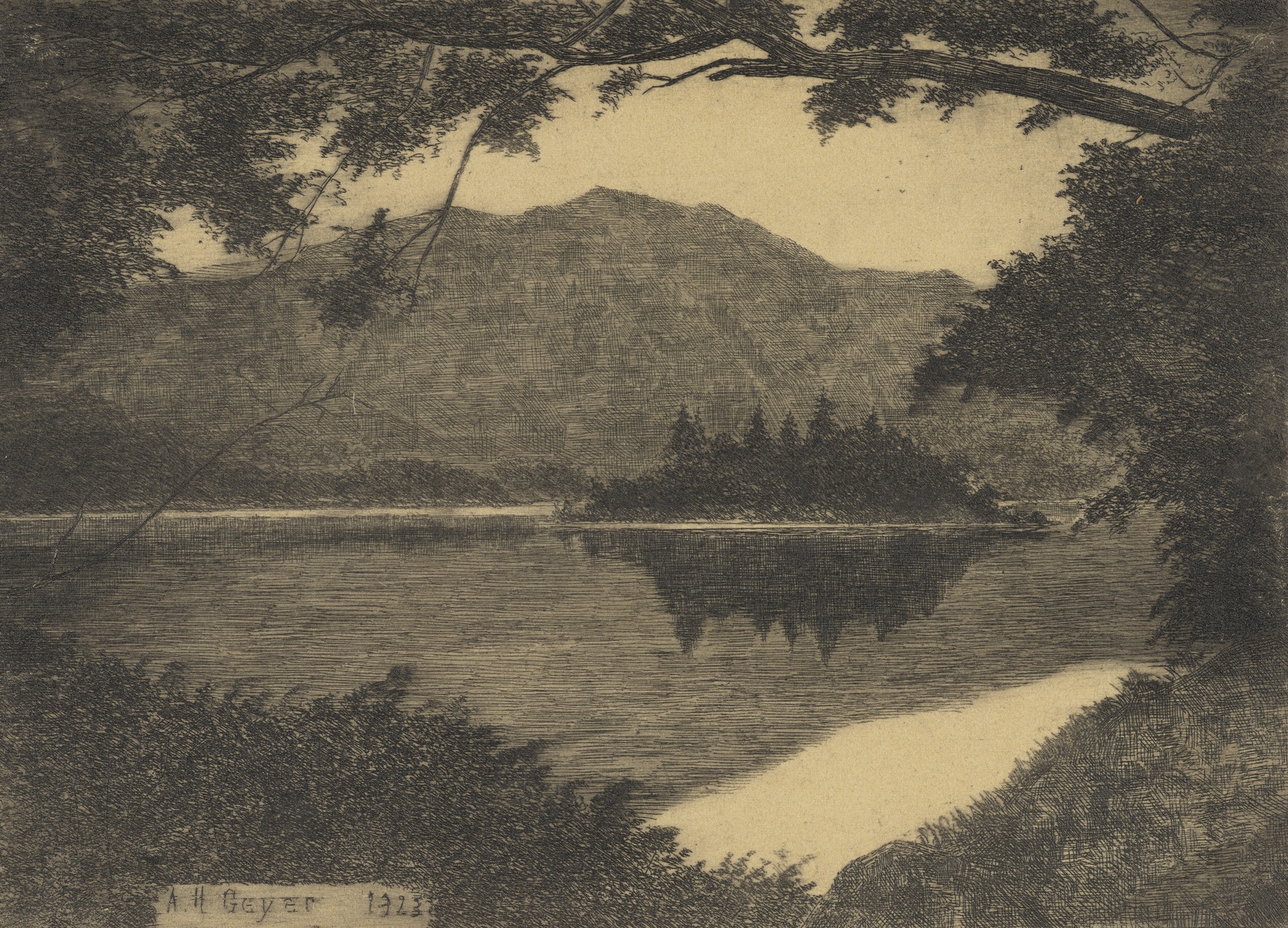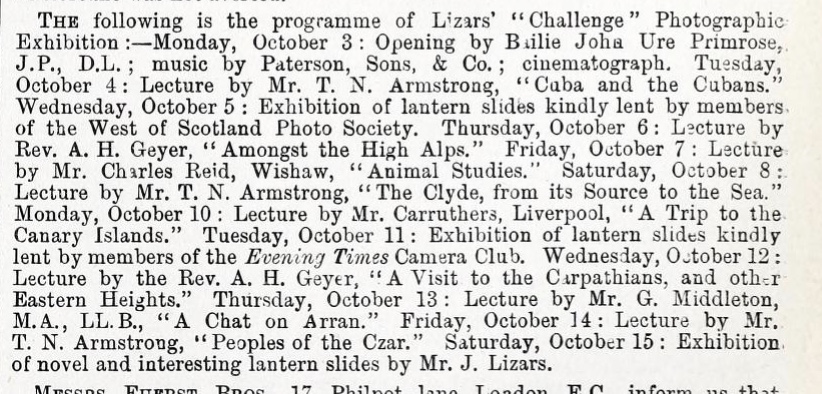This is the oldest photograph we have of members of the Arlington Baths Club.
Captioned Early morning swimmers at the Arlington Baths, it dates from 1896.
The name of the photographer – Pastor Geyer – is also written on the caption.
But who was he?
Some of our members have done a bit of digging to learn more about him and in the process we discovered some fascinating facts about Glasgow at that time.
Including the German-speaking community in the city, which grew to around 2,000-3,000 people just before the First World War.
Adolphus Hanns Geyer, was born in the Austrian Empire in 1857. In 1867 a formal union was established between the Austrian Empire and the Kingdom of Hungary and the territory became Austria-Hungary, also often called the Austro-Hungarian Empire. Many people in the Empire spoke either German or Hungarian, but many other languages were also in use including Italian, Polish, Czech, Serbo-Croatian, Slovenian, Rumanian and others.
See more about the German-speaking community in Glasgow and Geyer’s origins in Austria-Hungary.
Living in Glasgow
It’s not clear exactly when Geyer first came to Glasgow but in 1882 he organised a popular series of religious gatherings for German seaman and emigrants who passed through the city on journeys across the Atlantic Ocean. He then got a job with a new German seamen’s mission, where his self-declared aim was to ‘lift the spirits of the transient emigrants’.
He got married in Glasgow in 1886. He was 28 years old, living at 5 Ruthven Street in Partick, and his profession was described as “German Missionary”. His father John Geyer was described as “Minster of the Austrian Lutheran Church”. Both his father and his mother, Henrietta, were deceased.
His wife was 21-year-old Annie Ellen Strong, of 30 Elmbank Crescent, in Glasgow’s Charing Cross. Her father, Andrew Strong, had been a merchant. He had died when Annie was a baby but her mother, Rebecca Strong, nee Throrogood, was alive. She had trained with Florence Nightingale, and in 1879 was appointed Matron at Glasgow Royal Infirmary was a pioneer in establishing new nationwide training schemes for nurses. She believed strongly in equality of education for women and that women shoud have fulfiling, productive lives. There’s a lot more about her on the Friends of Glasgow Royal Infirmary website.
One of the witnesses at the wedding for Adolphus Hanns Geyer was Joseph Leckie, the Minister of the United Presbyterian Church in Ibrox, and it was with the United Presbyterian Church, that Geyer then undertook his divinity studies.
See more about the United Protestant Church, Reverend Joseph Leckie and Geyer.
The German Protestant Church in Woodlands
The German Protestant Church opened in October 1890, with Geyer as the Pastor. The church was in South Woodside Road, in Kelvinbridge.
According to The Herald newspaper of 10 October 1890 the church had brick foundations up the floor level but the building was was mostly constructed of wood which was painted soft sage green colour outside. The bell turret was a moulded dome, covered with copper, with a ornamental finial on top.
In a report of the opening, The Herald described it as a “Comfortable and artistic little church filled in every part by a congregation composed of Germans resident in Glasgow and their English-speaking friends.”

Growing family
By this time Geyer and his wife Annie Ellen (Nellie) were living at 20 West Bank Terrace in Hillhead. They had two children, Adolph R H, aged four, and Hildagard E, aged two. Also living there were Hermann K E Stellar, an 21-year-old relative from Hungary, who was a marine engineer. The specific relationship is not recorded but he may have been relative of Adolphus’ mother, whose maiden name was Steller. There was also a lodger called August R Abe, 21, who was an engineering draughtsman, plus a young women servant.
In 1901 the family had expanded, so as well as Adolph, now aged 14, and Hildagard, aged 12, there was now also Ernest W, aged eight, Annie E, aged six, and Westall Stelber, aged two years old. They now lived at 20 Smith Street South in Partick.
The Arlington Baths had members from the German-speaking community, including Adolphus Hanns Geyer. We have found his name in the Arlington Baths Club Members Roll, 1889-1894.
Art, photography and tourism
Pastor Geyer was a man of many interests. He was a talented artist who exhibited with the Glasgow Institute of Fine Arts.
He travelled in Scotland and abroad to seek subjects for his etchings and photographs, being particularly drawn to wild rugged landscapes such the Scottish Highlands and the Alps.
The National Galleries of Scotland hold one of his etchings of Loch Achray in the Trossachs.

He also spoke on photography including two lectures at the Lizars’ Challenge Photographic Exhibition 1897 entitled ‘Amongst the High Alps’ and ‘A Visit to the Carpathians and Other Eastern Heights’.

There’s a mention of him on the RKD – Netherlands Institute for Art History – website, where there are copies of two of his etchings, printed in a book around 1912, depicting a church and a canal in Dordrecht.
As well as travelling for his own pleasure he also organised sketching and educational excursions in Scotland and abroad for small groups; all part of the Victorian’s enthusiasm for tourism.
See more about Geyer’s art and tourism in Soctland
Ministering to many flocks
In a 2016 article, Professor Stefan Manz explains that he identified 1,053 Germans in Glasgow in the 1901 census, largely involved in trade and commerce but other occupations included “teachers, musicians, brewers, restaurateurs, hairdressers, miners, butchers, and a range of craftsmen such as watchmakers and bottle makers”. However the full community was more likely to have been between 2,000 to 3,000 people.
“During the 1880s, a former engineer turned pastor, Hanns Geyer, built up a congregation both for German transmigrants on their way to America, as well as the local migrant community. The United Free Church in Scotland praised the “continued and increasing success of his mission labors.” His services were attended by up to 80 churchgoers. In 1884, he was also employed as a seamen’s missionary for Glasgow by the newly founded General Committee for German Seamen and Emigrant Mission in Scotland.”
(“Germans like to quarrel” Conflict and belonging in German diasporic communities around 1900, Interdisciplines. Journal of History and Sociology, Volume 7, number 1, pg 49)
In his article Professor Manz explains that though there was a significant community of Germans and German-speakers in Glasgow they were not a homogenous group and did not always agree.
“In the long run, however, Geyer failed to gather support from the wealthier middle classes, crucially the ethnic leaders. He mainly appealed to the working class segment, and class reservations can be detected behind negative comments. Pastor Wagner-Groben from Edinburgh reported to Berlin that he had heard “discouraging judgments from very respectable people” about Geyer’s abilities and character, and merchant Carl H. Römmele came to the conclusion that Glasgow needed “a missionary or preacher for the poor, and one for the better classes.” [letter, 1885] Indeed, in 1898 a second congregation was founded with a clear agenda of class differentiation. In the words of timber merchant and leading ethnic figurehead Johannes N. Kiep, this was “established at the initiative of the better German circle” [letter, 1886] and for some time it had the reputation of being a “church for the rich.”
(Interdisciplines, pg 49/50)
Though artisans did join the new church it remained very much the preserve of richer merchants and businessmen. And there was a tense, sometime quarrelsome, relationship with Pastor Geyer’s church with its more working class congregation.
Manz describes how “Middle-class voices continued to refer to former engineer Hanns Geyer as a “locksmith.” (Interdisciplines, pg 50)
Find out more about Pastor Geyer’s role in ministering to marginalised communities
A family of medics
Three of the children of the Geyer family went into the medical professions.

Adolph Robert Hanns Geyer received his medical qualifications from the University of Glasgow in 1914. His younger brother Westall Stelbar qualified, also at Glasgow, in 1922. They are both listed in the 1925 medical Directory – Adolph at 39 Smith Street in Hillhead and Westall at 282 Woodlands Road, with the qualifications Bachelor of Medicine (M.B) and Bachelor of Surgery (Ch.B).
Adolph had served in the Royal Army Medical Corps as a captain and was a member of the British Medical Association. Westall later married and moved to Yorkshire.
Annie became a registered nurse in October 1925, following training at the Royal Infirmary in Glasgow. In 1938 she and her mother were still living in Glasgow, at Novar Drive.
Pastor Geyer died in the Royal Infirmary of stomach cancer on August 3rd 1931.
We still have much to discover about the German and German-speaking community in Victorian and Edwardian Glasgow and their connections with the Arlington Baths.
Many thanks to Arlington members Mark, Lindsay, Jon and Will for their research into Pastor Geyer.
Lucy

